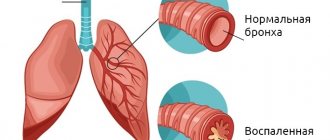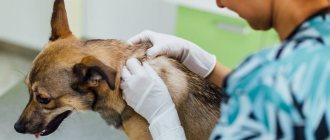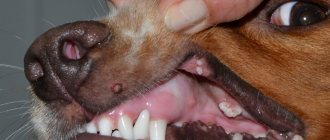Papillomas are skin growths that appear as a result of the activity of viruses. Eight strains of papillomaviruses have been identified in dogs. As a rule, neoplasms appear on the skin and mucous membranes.
Papillomaviruses also occur in humans, so it is worth reading about them in the article on HPV.
How is the virus transmitted? Infections can be transmitted from a sick animal to a healthy one; it can be acquired at dog playgrounds, through grooming items (bowls, brushes, dog toys, carrying bags). The incubation period of the disease lasts about two months. The virus is also dangerous for humans.
The infection enters the body through existing lesions on the skin. In most animals, the strain does not reveal itself in any way. The manifestation of the disease can be triggered by a weakened immune system or be a consequence of severe stress.
Why do papillomas appear in dogs?
Papillomas are mainly single skin growths of varying sizes. They are small bumps that resemble a cone in shape. The body of papillomas contains blood vessels. When papillomas are injured, they begin to bleed and often become inflamed.
In the presence of concomitant infection, multiple papillomas appear, spreading throughout the body or occupying large areas in the places where they are localized.
Benign neoplasms develop in young animals. Papillomas located in the mouth (on the gums, tongue, inner surface of the cheeks, lip) are very contagious and are easily transmitted from one animal to another.
Papillomas in the mouth can also appear in people, so you need to be prepared for anything.
conclusions
Self-medication can be used if the problem is minor.
If the papilloma is located in a place where it is impossible to reach at home, it is better to contact a specialized clinic. If a papilloma is found in a dog in one place, it is necessary to carefully examine the skin for multiple formations in order to provide assistance in a timely and qualified manner.
If the papilloma is difficult to remove at home, you should contact the clinic.
Doctors' opinions on the most effective methods of treating warts and papillomas
The chief physician of Moscow City Hospital No. 62 describes his vision on this matter. Anatoly Nakhimovich Makhson Medical practice: more than 40 years.
“I have been treating people’s papillomas and warts for many years. I’m telling you as a doctor, papillomas along with HPV and warts can really lead to serious consequences if they are not dealt with.
The human papillomavirus is present in everyone on whose body there are papillomas, moles, warts and other pigmented formations. According to rough estimates, 80-85% of the planet's population has it. By themselves they are not dangerous. The problem is that an ordinary papilloma can become melanoma at any time.
These are incurable malignant tumors that kill a person in just a few months and from which there is no salvation.
Unfortunately, in Russia and the CIS countries, pharmaceutical corporations sell expensive medications that only relieve symptoms, thereby hooking people on one drug or another. That is why in these countries there is such a high percentage of cancer diseases and so many people suffer from “non-working” drugs.
The only drug that I want to recommend, and it is also officially recommended by WHO for the treatment of papillomas and warts, is Papinol. This drug is the only remedy that has an effect not only on external factors (that is, it removes papillomas), but also acts on the virus itself. At the moment, the manufacturer has managed not only to create a highly effective product, but also to make it accessible to everyone. In addition, within the framework of the federal program, every resident of the Russian Federation and the CIS can receive it for 149 rubles.”
To find out more, read this article.
The older the dog, the more areas on its body that can be affected by papillomas. They can be located on the animal's paws, ears, neck and above the eyes on the eyelids. The growths in older dogs are denser and harder.
The causes of papillomatosis in dogs are associated with the activation of papillomaviruses. The growths cause significant discomfort to the dog. What should be done in this case, especially if the papilloma is inflamed and growing? How to carry out treatment?
In the first stages, the disease affects the lip area. If timely treatment is not carried out at this time, papillomas develop over the entire surface of the oral cavity (in the area of the upper palate, on the tongue on the lip, under the tongue, in the pharynx).
When multiple formations appear in the mouth, it becomes painful for the animal to drink and chew food. The dog may begin to refuse to eat solid food, lose weight, and may bleed from the mouth area. Multiple growths prevent the animal from closing its jaw tightly. Papillomas are constantly injured and infection easily penetrates them. The disease is often complicated by the formation of fungi and bacteria in the inflamed area.
Important! Damaged papillomas often degenerate into an oncological disease - carcinoma! The risk of developing such a disease especially increases in animals weakened as a result of the disease and in old dogs.
How can papillomatosis in dogs be treated? In most cases, spontaneous recovery from the disease is observed, however, if papillomatosis spreads to large areas of the skin or the tumor increases in size, the best thing that can be done is to show the dog to a veterinarian for diagnosis and treatment, and do not resort to traditional home remedies. conditions. How can you remove papillomas? Drug treatment in a veterinary clinic comes down to the following treatment options:
- Injections of the drug roncoleukin. There are several treatment regimens, but they all boil down to administering the drug using an insulin syringe at the base of the papilloma. Injections are administered over 11 to 15 days. The duration depends on which treatment regimen is used.
- Intravenous injection of novocaine into the base of the wart. The medicine is administered three times with a break of 3 days between injections.
- Prescription of antiviral drugs and immunomodulators. Cycloferon injections are used.
- Rubbing in anti-verrucin paste. The affected areas are treated until the tumors completely disappear.
- Use of forsprenil. The drug is effective against most papilloma viruses. It can be injected into the body intramuscularly and subcutaneously, it can be instilled into the eyes and nose of the dog, and it can be used to lubricate the oral cavity. Basically, when treating papillomavirus in dogs, forsprenil injections are given subcutaneously (in the withers area). After about two weeks, most of the warts disappear.
When using ointments and creams for papillomas, a cardboard collar is placed around the dog's neck to prevent the animal from licking the medicine.
What to do if a papilloma appears in a dog’s ear? Papillomas that appear in an animal’s ears can be very small in size, but there is a possibility of their strong growth and enlargement.
The inner surface of the ears is a very delicate and sensitive area. Often, to eliminate discomfort, the dog begins to scratch its ears with its paws. As a result, blood appears, the wound becomes inflamed, and:
- the animal is worried, whines, scratches its ears;
- inflamed papillomas emit an unpleasant odor;
- There are scratches and small scars around the areas affected by warts.
Upon careful examination, you can detect papillomas not only on the ears, but also on the mucous membranes of the genitals, on the eyelids, in the oral cavity and other places on the dog’s body.
Treatment of papillomas in the area of the ears is in most cases carried out by laser removal. This is the most acceptable method of removal, since the dog’s ears are very sensitive and any manipulation can be painful.
Attention! If multiple papillomatosis caused by a viral infection spreads throughout the dog’s body at high speed, the papilloma darkens or becomes almost black, the main thing to do is to immediately contact a veterinarian for treatment. A change in the color of papilloma can be a signal of cancer development in a dog!
If, during examination of the dog, the papilloma is accidentally cut off and it bleeds, the wound should be carefully treated with an antiseptic and the animal should be taken to the veterinarian.
Methods for treating infection in animals
Removal of papillomas in dogs occurs under local anesthesia. There are several ways to rid your pet of an unpleasant illness:
- cryosurgery;
- surgical excision;
- electrocoagulation;
- laser.
Treatment of human papillomavirus disease by surgical removal is carried out by a veterinarian. Surgical excision is often performed because this method is the most accessible, safe for the animal and will definitely get rid of the wart. After surgical removal of a wart, it requires good care and regular dressing changes.
The natural resistance of the animal’s body will be strengthened by immunomodulators. They are prescribed to increase the pet's immunity. Stimulants are used as a complement to the main therapeutic agent. Has proven itself well:
- Gamavit;
- Interferon;
- Immunofan;
- Transfer Factor.
The best treatment for papillomatosis is Fosprenil. This medicine is used in a dosage of 3 ml per 10 kg of weight, it is used once daily. The course of treatment is 5 days. Fosprenil is used to treat benign growths in the oral cavity. After 1.5–2 months, it is necessary to repeat the treatment.
What to do if your dog has a papilloma on his lip?
Papillomas on different parts of the animal’s body (on the stomach, back, paws) can be exposed to aggressive liquids (dandelion juice, cauterizing substances, celandine, Super celandine) and ointments. Papillomas on the mucous membranes cannot be treated using these methods. What treatment is needed in this case and what to do?
Papillomas from the mucous membranes can be removed using a laser and surgery. However, the latter method is used very rarely, since complications may arise after removal with a scalpel.
How to treat papillomas that appear on a dog’s face? Papillomas can appear on the animal's face. How is warts localized on a dog’s nose treated?
A few formations can be wiped with forsprenil.
Attention! If the affected areas are treated with a medicinal solution, it is recommended to simultaneously treat with intramuscular antiviral drugs.
What types of papillomas are there (description with photo)?
The virus is capable of infecting cells of the skin or mucous membranes. It is rarely malignant in nature, but sometimes degenerates. The owner should be especially concerned about warts that have begun to grow rapidly or bleed. Depending on external characteristics and location, warts are divided into the following types:
Oral papillomas
- Papillomas of the oral cavity. As a rule, they occur in young animals. The virus affects the mouth, nose, lips, tongue. As you can see in the photo, warts can have a diameter of up to 1 cm, white or gray in color. The disease is very contagious, but it is transmitted exclusively to dogs and does not threaten the owner.
Transitional cell neoplasm
- Transitional cell neoplasms. The disease usually affects young animals. It looks like a round tumor covered with small pimples, which are found in sponges. The growth is easy to recognize by comparing it with the image in the photo. Such papillomas often appear under the arms or on the stomach, but sometimes they are also found on the pet’s ear or eye.
- Skin warts. This virus is usually localized on the animal's paws and back. It leads to the appearance of benign lumps, the size of which almost never exceeds 1 cm. Outwardly, these papillomas resemble a tick. They do not cause any particular discomfort to the dog. The exception is skin lumps that form on the paws. The disease most often affects older dogs.
- Pigmented papillomas. These growths are located mainly on the abdomen of small breed dogs. Outwardly, they look like a sulfur match head with a thin base. If the disease gets worse, there will be a lot of papillomas and they will become covered with scales.
- Genital warts. The disease is extremely rare in dogs. These are single tumors of small size.
Therapy for the disease can have several directions. Warts in dogs usually appear due to a loss of strength in the animal, so treatment is aimed at restoring the dog’s immunity. The second therapeutic direction is the fight against the growth itself. It can be cut out with a scalpel or destroyed with substances that can decompose cells. The choice of a specific remedy to combat papilloma will depend on its location, size and structure.
Conservative therapy
There are special medications that veterinarians have been using to treat dogs for many years. For papillomatosis, the following medications are used in veterinary medicine:
- Novocaine. The drug at a concentration of 0.5% is administered to the dog intramuscularly. The dosage is calculated according to the following formula: half a milliliter of the product is taken per 1 kg of animal weight. Veterinarians recommend administering the medicine very slowly and carefully, while constantly monitoring the dog. If the dog begins to get nervous, his pulse quickens, the administration must be stopped. The course of treatment should consist of 3-5 procedures, between which you need to take breaks of 4 days.
- Local use of Novocaine. The drug can also be administered directly under the seal in a dosage of 0.5 ml. Injections are recommended every 2-3 days until the formation disappears.
- Gamavit. This drug is an immunomodulator that helps increase the animal’s body’s defenses. The dosage and schedule of administration of the drug should be prescribed by a doctor. You can use the instructions for the drug and calculate the dose yourself. Analogues of Gamavit are Maxidin, Fosprenil.
- Iodine. Papillomas can be cauterized with a regular alcohol solution of iodine. However, a sore that appears on the oral mucosa or on the lower eyelid cannot be removed using this method.
Papillomas in dogs were once effectively treated with herbs. In this regard, dandelion, celandine and garlic juice have proven themselves well. The product should be lubricated daily on the sore spot. To remove sores on the oral mucosa, you can use a mixture of castor oil and baking soda. Lubricating warts with a mixture of linseed oil and honey has a good effect. At home, traditional methods are the most acceptable because they do not pose a danger to the dog.
Surgical intervention
If conservative treatment does not give any results, in cases where therapy requires serious measures due to damage to the lump, it should be removed surgically. You can operate on a dog using a scalpel, but today innovative technologies are increasingly used for this.
Laser treatment of warts provides a much better effect. This method is considered minimally invasive, and at the same time it allows you to remove the entire tumor without any traces. It is believed that the operation is painless, but veterinarians administer local anesthesia before it to remove as much discomfort as possible from the treatment.
Another option for fighting is cryodestruction. The essence of the method is to use liquid nitrogen to freeze the wart. Under the influence of very low temperatures, pathological cells are destroyed, after some time only a small scar remains at the site of the lump. True, this procedure is also not pleasant.
How to treat papillomas that appear on different parts of the animal’s body?
Papillomas can appear on different parts of the dog’s body: on the neck, on open areas of skin (on the stomach), on the thigh, on the back. The formations can be of different colors: pale flat growths of the same color as the skin, reddened or flat papillomas, gray warts. All treatment methods can be reduced to methods of removing growths and supportive drug therapy under the guidance of a veterinarian. The most commonly used:
- Cryodestruction – removal using exposure to low temperatures (freezing).
- Electrocoagulation – removal using current.
- Using a laser – burning out growths using laser radiation.
Prevention
To prevent the formation of papillomas, you should adhere to the following preventive measures:
- Check your pet daily after walks. Pay special attention to dogs with long hair that makes access to the skin difficult.
- Maintain a balanced diet. A strong immune system will help protect the body from infections.
- Use the vaccine. Injections are the best way to protect against the disease.
- Avoid contact with stray dogs. When requesting foster care, make sure the animal is healthy.
- Perform a preventive examination at least once a year. The doctor will detect tumors in areas inaccessible to the normal eye.
How to treat papillomas in a dog's mouth?
How can papillomas on the inner membranes be treated? Neoplasms in a dog's mouth, localized on the tongue, or palate, or other places, can be removed using laser excision. Treatment can be carried out using treatment of the oral cavity with forsprenil with simultaneous intramuscular injections of this drug or cycloferon into the withers area.
How is papilloma on the eye treated? Formations that appear on a dog’s head can be treated with ointments for papillomas (salicylic and colchamine ointments, Lorinden). Particular care should be taken when treating papillomas that appear in the area above the eyes and on the eyelid.
Attention! You cannot treat papillomas that appear in the dog’s eye area yourself! Incorrect treatment methods can damage your vision! If tumors appear in this area, you should contact a veterinary clinic.
You need to be careful, since papilloma in the eye area and eyelids is dangerous not only for the dog, but also for its owner.
Making a diagnosis by a veterinarian will not cause any difficulties. Laboratory tests may be required to determine the correct treatment.
If the papilloma in the eye area becomes pathological, it will require immediate removal, which can only be performed in a veterinary clinic.
How is the diagnosis carried out?
The main goal of diagnosis is to confirm the benignity of neoplasms and establish their connection with the papillomavirus. The answer to the second question allows us to obtain a specific laboratory analysis, which, thanks to the COVID-10 pandemic, is now known to everyone. We are talking about polymerase chain reaction (PCR) - a technique that allows you to identify in a blood sample primers (fragments) of deoxyribonucleic acid inherent in the genome of a particular virus known to medicine.
Did you know? In addition to diagnosing viral infections, the PCR technique is also used to establish paternity, as well as DNA analysis in forensics.
To exclude malignancy of a tumor, a biopsy is traditionally used - taking a sample of affected cells for laboratory testing (electron microscopic, immunohistochemical and cytological).
How to treat papilloma on the paw?
When a tumor appears on a dog’s paw, a medical examination and laboratory diagnostics are performed to determine the type of virus. For analysis, a tissue sample of the growth is taken and examined. Thus, it is determined whether the neoplasm is benign in nature, and the presence of pathological cells that can cause the development of cancer in the dog is examined, which in severe cases leads to the removal of the paw. After this, appropriate treatment is prescribed.
Therapy can be carried out by treating the paw with medicinal ointments and creams using novocaine injections into the area of papilloma or injections of other antiviral drugs.
New growths can be excised with a laser, treated with celandine or other active liquids, papilloma tissue can be frozen, and removed with a certain amount of current. All treatment methods are prescribed by a veterinarian.
Attention! You should not resort to self-treatment of papillomas in dogs! Removing tumors can provoke their growth and lead to cell degeneration! Various infections can penetrate into wounds, which can provoke the development of other diseases.
All aspects of prevention, nuances of treatment and possible prognoses of papillomatosis in dogs are covered by a popular veterinarian-video blogger:
Routes of infection and mechanism of development
A dog can become infected with papillomatosis through direct contact with a carrier of the virus (during walking, training), as well as through care items, clothing or the hands of a person who has previously come into contact with a sick animal. There are more than a dozen types of Papovaviridae virus, some of them infect only animals, others only humans. Therefore, a person cannot become infected with this disease from a dog.
The virus enters the dog’s body through damage to the skin - microcracks or scratches. Penetrating into the cell nucleus, it may not be active for some time, and remain in a “dormant” state for one to several months. Causes that provoke the development of the disease can be a decrease in immunity due to stress, a previous illness, or taking corticosteroid drugs that suppress the immune system. The presence of these factors triggers the process of replication (multiplication) of the virus.
Cells in whose DNA the foreign agent has embedded its “program” begin to divide uncontrollably, resulting in growths in the form of warts appearing on the skin or mucous membrane, reminiscent of papillae or cabbage inflorescences collected in a bunch. Neoplasms are benign in nature, but with frequent injury they can degenerate into a malignant form.
What to do at home
Many owners prefer to treat papillomas in dogs using traditional methods, without seeking help from specialists. Meanwhile, self-medication is dangerous for your pet’s health and can lead to serious consequences. Traditional methods can be used, but only after consultation with a veterinarian and in combination with conservative therapy (if treatment is medicinal).
You can lubricate warts with celandine juice. The juice that flows near the root of the medicinal plant is used. Over time, the tumor will begin to turn black, after which it is carefully cut off, while treatment of the affected area should continue. Over time, the tumor disappears.
Garlic, dandelion juice, acetic acid, ice, and raw berry mixture have also proven themselves well.
Recovery prognosis
The prognosis depends on the type of tumor. Removal of benign tumors has a completely optimistic prognosis. And for carcinomas, adenocarcinomas and sarcomas, it depends on what stage the dog’s mammary gland disease was at at the time of diagnosis. The earlier treatment was started, the better the prognosis.
There are a number of factors that always influence forecasts:
- tumor size;
- growth rate;
- the possibility of its complete removal;
- presence of metastases;
- damage to the lymph nodes.
Are warts dangerous?
Most veterinarians are of the opinion that warts in dogs are a phenomenon that does not require close attention. An animal with normal immunity recovers without treatment. The exception is when the dog suffers from a large number of rashes.
Photo. Papilloma on a dog's lip.
In addition, the animal can tear off the wart during scratching or other mechanical stress. In this case, there is a risk that an infection will get into the wound. The second dangerous point is the degeneration of papillomas into a cancerous tumor.
In what cases is treatment of warts necessary:
- if they are located in the mouth and interfere with chewing;
- if warts affect the eye area;
- if there is a risk that the dog will injure the wart;
- if a malignant tumor is suspected.
Important! In any case, it is worth showing your pet to a veterinarian, since a wart can be confused with other types of skin tumors (fibroma, lipoma, melanoma, sebaceous or sweat gland adenoma).
Features of formations depending on age and location
The virus that causes growths enters the animal's body through wounds. If a dog’s immunity is good, then the owner may not know that it is infected throughout its life, since the natural defense will suppress the pathogen. When immunity declines, papillomas begin to appear. The virus is not dangerous for humans, and even if an infected animal bites through the owner’s skin, papillomas will not begin to appear. People have their own strain of papillomavirus, which in turn does not transmit
How do the symptoms of the disease manifest themselves?
First of all, any tumor is felt as:
- a dense or soft lump under the skin;
- it feels loose (diffuse) or nodular to the touch;
- attached to tissues and completely motionless or vice versa.
The lump may be located inside the breast or above the nipple, in the milk duct, fat or connective tissue. May be painful, but not necessarily a symptom. A breast tumor may also differ in color from the surrounding tissue, but this is also not a necessary condition.
Therefore, the only thing that is important for the dog owner is that if you find any suspicious swelling on the sternum, you need to show your pet to a doctor. The oncologist will determine why the mammary gland is swollen, determine whether it is cancer, mastopathy or something else, find out the stage of development of the tumor and determine the course of treatment.
It is impossible to find out what exactly the pathology is based on external signs. Unlike other diseases, symptoms are not species specific. To do this, tissue samples are carefully examined under a microscope.
Features of individual types of tumors:
| Type of breast tumor | Characteristics |
| Carcinoma | Characterized by rapid growth, doubling its volume in a short time. On palpation, a capsule is felt that cannot move freely. The skin is often ulcerated, and the tumor itself penetrates the lymphatic vessels and lymph nodes. Diameter - 2–30 cm. The shape can be round, ovoid, discoid, mushroom-shaped or indeterminate. |
| Adenocarcinoma | Soft to the touch. If you look at the section, it has a diffuse structure of white-cream color. |
| Papillary carcinomas | The tumor is hard to the touch. Irregular in shape. |
| Intraductal papilloma | This is one large lump-like pathology at the nipple and several smaller ones. |
Features of canine papillomavirus
Papillomaviruses are transmitted through direct and indirect contact with an incubation period of 1-2 months. In dogs, papillomas can persist for up to 4-6 months in the oral cavity and 6-12 months on the skin before regression occurs.
Cellular immunity is responsible for the regression of papillomas; immunosuppressive conditions (including feline immunodeficiency virus) and immunosuppressive drugs may intensify and prolong infection.
At least 5 types of canine papillomaviruses and up to 8 types of feline papillomaviruses have been identified; each has a distinct clinical picture or site of infection.
Canine oral papillomatosis
Young dogs are most often affected. Canine oral papillomatosis is usually a self-limited infection of the mouth and lips; it sometimes infects the nose, conjunctiva, and hairy skin.
The lesions appear as multiple smooth white papules and plaques and progress to warty, cauliflower-like lesions. The lesions usually regress within 3 months.
Skin papillomas (exophytic)
They are most common in older dogs. Cocker spaniels and Kerry blue terriers may be predisposed. Lesions usually involve the head, eyelids and feet. The lesions appear as single or multiple, flesh-colored or pigmented, pedunculated, hairless, smooth or leaf-like masses that are usually less than 0.5 cm in diameter.
Transitional cell papillomas of the skin
They are most common in young dogs. They appear as a self-limiting disease with lesions most commonly found on the ventral abdominal and axillary areas. Lesions are single or multiple, 1-2 cm in diameter, round, raised with a central depression.
Multiple pigmented plaques
They are most common in young miniature schnauzers and pugs; they may be congenital, inherited in an autosomal dominant manner.
They appear as non-progressive lesions that are found on the lower torso and medial thighs. The lesions begin as pigmented macules and plaques that progress to scaly and hyperkeratotic flat masses.
Some lesions may undergo malignant transformation into squamous cell carcinomas.
Genital papilloma
It is an infrequently reported and incompletely described sexually transmitted form of human papillomavirus infection. The lesions appear as raised papillomatous plaques on the penis or vaginal mucosa.
Papilloma of the fingertips
It is an uncommonly reported disease in adult dogs. It has not been fully proven to have a viral cause.
(However, the author treated 2 cases of fingertip papilloma, one of which demonstrated papillomavirus antigen on immunohistochemical examination and both responded to immunomodulatory therapy with interferon).
The lesions are hard, keratotic masses on several finger pads. Interdigital lesions have been described in greyhounds. Lameness and secondary bacterial infection may occur.
Treatment methods
- Dermatohistopathology: epidermal hyperplasia and papillomatosis with ballooning degeneration of epidermal cells.
- The papillomavirus antigen can be detected using immunohistochemistry or PCR.
- Most papillomatous infections resolve spontaneously after the body develops a cell-mediated immune response.
- Surgical methods can be used in the presence of persistent solitary lesions, but tissue must be handled carefully to avoid the spread of viral particles from the surgical site.
- Cryotherapy and laser ablation are often effective, but repeat treatments may be required.
- Azithromycin, 5-10 mg/kg orally every 12-48 hours in dogs and cats has demonstrated variable effects and minimal side effects.
- Interferon, 1.5 -2 million units/square meter subcutaneously 3 times a week for 4-8 weeks (2 weeks after clinical recovery) is sometimes successful in cases of oral or cutaneous viral papilloma in dogs and cats.
- Occasionally, 5% imiquimod cream applied topically every 24 to 48 hours until lesions resolve has been used successfully in cases of canine skin papilloma and feline Bowen's disease. To prevent licking and swallowing of the drug, it is necessary to install an Elizabethan collar.
- Autogenous vaccines and immunomodulatory drugs (eg, levamisole, thiabendazole) have unproven effectiveness.
- A new recombinant canine oral papillomavirosis vaccine developed by Georgetown University Medical Center has shown promising results in the treatment of refractory canine oral papillomas. It consists of the major envelope protein L1 of canine papillomatous virus.
Oral papillomas had completely regressed by the time of the last vaccination with no relapse after 60 months.
Oral retinoids (eg, acitrein 0.5–1 mg/kg po q24h) were reported to be helpful in one case of canine transitional cell papilloma and canine pigmented plaques.
Antimetabolites can be used to inhibit DNA synthesis and proliferation.
Topical application of 0.5% fluorouracil solution every 24 hours for 5 days, then every 7 days for 4-6 weeks for skin disease (dogs only).
An Elizabethan collar should be placed on the dog to prevent ingestion of the drug, and owners should wear rubber gloves. Contact dermatitis or systemic toxicity may occur.
The prognosis is usually good, since spontaneous regression occurs in most cases. Malignant transformation to squamous cell carcinoma is possible for pigmented plaques of dogs and multiple viral papilloma of cats and in rare cases with oral and corneal papilloma.
Source: https://veter96.ru/htmlpages/Show/dermatologicheskij-atlas/-papillomy-u-sobak-i-koshek2
What to do if papillomas appear
In most cases, papillomas on a dog’s body appear spontaneously and disappear spontaneously. If the wart does not bother your pet in any way, then there is no need to touch it.
Several years ago, our Jackusik developed a small growth in his ear area. He didn't bother our little dog in any way, but of course he bothered me. In appearance, the growth resembled a small dense pea that accidentally got under the skin. No fur grew on it. I watched this growth for some time. When going to the veterinary clinic for a routine annual vaccination, I showed the doctor this tumor. To which the doctor answered me unequivocally that if he doesn’t bother Juzik in any way, then there’s no need to touch him, but just observe him. Now, if the growth begins to increase and “multiply”, then measures should be taken. Literally 2 months have passed and I have already “got used” to the fact that when I stroke my little tail’s head, sometimes he “comes across” my hand. But one day I noticed that I did not feel this compaction either to the touch or visually. It resolved itself.
Why are these neoplasms dangerous?
Papilloma on the dog's body
It is not at all difficult to detect papilloma in a smooth-haired pet; to do this, you need to carefully examine the dog. With shaggy pets the situation is worse. Often, due to the dense vegetation on the body, warts are discovered only when the disease has reached a deep stage.
If papillomatosis has developed in an animal's mouth, it can begin to cause discomfort over time. It will be painful for the dog to chew food, and it will stop eating. An unpleasant odor will appear from the pet's mouth. If your pet bites on the lump while eating, it may bleed. A damaged wart often becomes inflamed, turning from a benign tumor into a malignant one.
Sometimes warts disappear on their own and do not appear for several years in a row, but more often they remain on the animal’s body for its entire life. In order not to miss the initial stage of the disease, the dog should be examined periodically. It is recommended to pay special attention to the eyes, ears, and mouth of the animal.
If you find a suspicious lump or ball, you should show it to your veterinarian. It is not recommended to remove a papilloma or wart yourself: this will lead to bad consequences.











